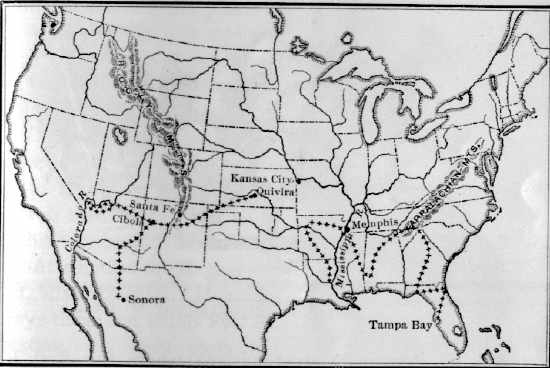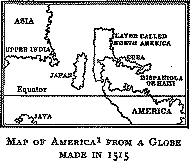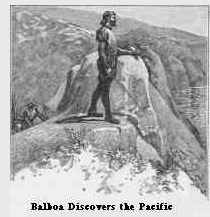Resource Center OLLibrary
|
18 |
|
[1507-1522 |
the map of two entire continents. If he deserved it, it is
right that he should have the honor; but that is a point which
cannot be settled. It may be that he has received by chance fame
which he did not fairly earn, and which, perhaps, he did not even
seek.
16. How America finally came to be considered
a New and Distinct Continent. But even after America was
named, the idea that it was a distinct and separate division of
the globe was not generally accepted. Some thought that South
America was a great island or southern continent (like Australia);
but the majority believed, with Columbus, that it was simply an
immense peninsula projecting from southeastern Asia. People,
indeed, spoke of the "New World," but all that they usually meant
by that expression was newly discovered lands.
The real character of America was first found by
Magellan, a Portuguese captain who crossed the Atlantic in the
early part of the 16th century. The King of Spain sent him on a
voyage to the southwest (1519), to see if he could find a new way
to reach the Spice. Islands. He discovered the strait which now
bears his name, and, passing through it, entered that great ocean
which he called the Pacific.
He pushed on westward until he reached the
Philippines, where he was killed by the natives. One ship of the
expedition kept on its course until it crossed the Indian Ocean,
doubled the Cape, of Good Hope (§ 6), and finally reached
Spain (1522). (Maps, pp. 5, 8.)
The Spanish King was so pleased with the result
that he gave the commander a 'coat of arms representing a globe
bearing the motto: "You first sailed round me."
Then men's eyes were opened to the truth. Then
they saw that America, instead of being a part of the Old World,
was in all probability an immense, independent continent, a real
NEW WORLD.
Was that discovery hailed with delight? Not at
all. Europe was still bent on finding "that hidden secret of
nature," -- a direct passage to Asia and the Indies, -- and there
stood America barring all progress. It is true that when the
Spaniards found gold and silver in Mexico and Peru, they became
reconciled in a measure to
|
1519-1522] |
|
19 |
|
their disappointment. Still, for more than a hundred
years after Columbus, most of the explorers spent their
efforts not so much in seeking to find out what was in
the new country, as in trying to hit on some passage
through it or |
I I
The discovery of America was "the great event which gave a new world not only to Spain, but to civilized man." -- CHARLES SUMNER.
COLONIZING AMERICA1
THE COUNTRY • THE NATIVES • EFFECTS
OF THE DISCOVERY OF
AMERICA ON EUROPE (1509-1600)
18. Ponce de Leon's Expedition; Discovery
of Florida. Early in the sixteenth century the Spaniards
conquered Cuba. A number of years later Ponce de Leon, governor of
Porto Rico, resolved to start on an exploring expedition to the
northward.
De Leon was growing old, but the Indians excited
him by telling him of a wonderful land not very far away. They
said that he would find plenty of gold there, and a fountain which
would make the old young again. He obtained a charter2
from the King of Spain, which gave him power to go in search of
that land of promise, and when found, to hold it as governor for
life. The veteran adventurer felt that if he could once bathe in
the waters of the miraculous fountain, and get back his youth, he
would be pretty sure of a long term of office.
After cruising about for several weeks he struck
the mainland of North America (1513). It was Easter Sunday, a day
which the
1 Reference
Books. R. G. Thwaites'" Colonies," pp. 1-7, 7-19, 27-44; F.
Parkman's "Pioneers of France in the New World," pp. 1-15, 85-162;
W. C. Bryant and Gay's "United States" (revised edition), I, ch.
7-10; L. Farrand's "Basis of American History" (The Indians), ch.
14-15; E. G. Bourne's "Spain in America," pp. 108-111, 133-136,
162-168, 169-174, 177-189; L. G. Tyler's "England in America," pp.
18-33; A. B. Hart's "Source Book of American History," pp. 6-14;
A. B. Hart's "American History by Contemporaries," I, 57-64,
81-95; G. Bancroft's "United States," I, ch. 2-5; N. S. Shaler's
"Story of Our Continent" (Physical Geography, etc.). See also the
classified List of Books in the Appendix.
2 Charter: a written grant made by
the king or head of a government, conferring certain rights and
privileges.
|
1513] |
|
21 |
|
Spaniards call Pascua Florida, or Flowery Easter.
Shortly after, De Leon landed at a point not very far
from where St. Augustine now stands. (Map, p. 29.) There
he planted the cross, |
|
22 |
|
[1513-1535 |
possession of it and of all lands bordering on it for the
sovereigns of Spain. Waving his sword, he said, "I am ready to
defend" their claim "as long as the world endures, and until the
final day of judgment of all mankind." He named that ocean the
South Sea because he first saw it to the south of where he stood,
but Magellan named it the Pacific (§ 16).
Not long afterward the Spanish general, Cortez,
landed in Mexico, conquered that country, and thus established the
power of Spain on the Pacific slope of the North American
continent.
Cortez saw what an immense advantage it would be
to Spain to cut a canal through the Isthmus of Panama. He
suggested it to the King, but that prudent monarch refused to
undertake a work which he said would drain his treasury of its
last cent. Nearly four hundred years later the United States hired
an army of laborers to "make the dirt fly." They dug the great
Canal through from ocean to ocean (§ 440).
20. French Explorations; Montreal. Up to
this time France had obtained no part of the New World. But the
King of that country did not intend to let the other powers of
Europe get it all. The Pope had, as we have seen (§ 12),
granted the new lands to the rival nations of Spain and Portugal,
but the King of France cared nothing for that. "Show me," said he
to the sovereigns of those nations, "the words in the will of
'Father Adam' which divides the earth between the Spanish and the
Portuguese, but shuts out the French." No one found it convenient
to produce the will, so the King of France sent out an expedition
(1524)1 to obtain his share of America.
Later (1535), Cartier,2 a French
navigator, discovered a great river in the northern part of
America, to which he gave the name of St. Lawrence. Ascending the
stream, he came to an island where he climbed a lofty hill. He was
so delighted with the grand view that he called the height
Montreal, or Royal Mountain.
1 This was the
expedition said to have been undertaken by Verrazano in 1524. He
states that he landed in the vicinity of Cape Fear, North
Carolina; then sailed about 150 miles southward along the coast,
and then, turning north, sailed to what is now New York Bay,
afterward cruising along the coast of New England.
2 Cartier made
his first expedition in 1534, to Newfoundland and the Gulf of St.
Lawrence.
|
1539-1541] |
|
23 |
21. De Soto's Expedition in the East.
Meanwhile De Soto, a Spaniard, as greedy for gold as he was cruel,
and as daring as he was greedy, set out on an expedition to the
west. He sailed from Cuba (1539) with a force of about 600 picked
men and over 200 horses.
The expedition landed at Tampa Bay, Florida, and
began its march of exploration, robbery, and murder. The soldiers
seized the natives, chained them in couples, and forced them to
carry their baggage and pound their corn into meal for
them.

DE SOTO'S EXPEDITION IN THE EAST, AND CORONADO'S IN THE WEST
In the course of two years, De Soto and his
men traveled upwards of fifteen hundred miles through what are now
the states of Florida, Georgia, Alabama, and Mississippi. They
picked up no gold worth mentioning, but, in place of it, they
found hunger, suffering, and death. They deserved what they
found.
At length, in 1541, the Spaniards, worn out,
sick, and disheartened, came out from the forest on the banks of
the Mississippi.1 There De Soto called a halt. He was
the first white man that had
1 Probably at or near
a place now called De Soto Front, De Soto County, in the
northwestern comer of the state of Mississippi.
 round
it which should be shorter and better than that which
Magellan had sailed through.
round
it which should be shorter and better than that which
Magellan had sailed through. raised
the Spanish flag, and in commemoration of the day when he
had first seen the coast, he named the country Florida.
Winter is almost unknown in that climate, and the dense
foliage and profusion of bright flowers fully justified
the name.
raised
the Spanish flag, and in commemoration of the day when he
had first seen the coast, he named the country Florida.
Winter is almost unknown in that climate, and the dense
foliage and profusion of bright flowers fully justified
the name.


